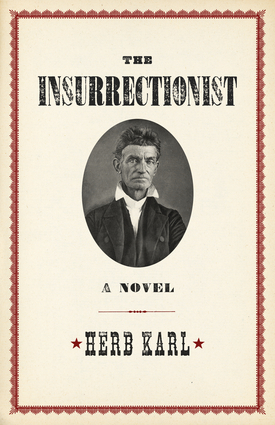The Insurrectionist: A Novel
- By Herb Karl
- Chicago Review Press
- 336 pp.
- Reviewed by Amelia Li
- May 29, 2017
This dramatized look at John Brown’s life is stuck somewhere between fiction and biography.

“A goal of mine in writing this novel was to capture the character of John Brown,” says author Herb Karl in his acknowledgments. The result is The Insurrectionist, a story that takes the man well known for his raid on Harpers Ferry and examines his motivations behind the ill-fated invasion.
On May 22, 1856, pro-slavery senator Preston Brooks canes abolitionist senator Charles Sumner until the cane “looked more like a cowhide whip with its plaited thongs unraveled.” The news reaches John Brown, who, reaffirming his belief that “no amount of moral persuasion” would ever sway the slaveholders, decides to strike fear into their hearts instead.
The Harpers Ferry raid was meant to do just that, as well as send a signal to willing soldiers to join him. But such a plan takes money and men. And you don’t amass donations or volunteers without being known as someone who gets results.
The focus of The Insurrectionist is thus on the hows of Harpers Ferry: how Brown gains a reputation for slaughtering slaveholders; how he charms like-minded men into following him; and how he wheedles benefactors for funds, all while using Christianity as a guide.
There is a full life in the three years before Brown’s execution on December 1, 1859. While Russell Banks’ Cloudsplitter also gives a larger glimpse of the abolitionist, it does so via dramatization through the eyes of Brown’s son, Owen. Karl’s intention is for Brown to speak for himself in a mostly neutral narrative.
In a note to the reader, Karl states another goal: “To bring the characters to life by imagining what they may have thought and said.” This is why he calls The Insurrectionist a novel. A biography is not likely to detail a scene in which Brown looks upon the coat that Senator Sumner wore during his caning as he would a religious artifact. There’s no doubt that certain liberties with the facts are at play.
It’s unfortunate, then, that a conflict arises — not the Civil War, but a conflict between the historical and the literary. The Insurrectionist feels like it wants to stay true to fact but still entertain, so while Karl lets loose on scenery, he glosses over the action by relying on summary.
Some scenes are deemed worthy enough to indulge in literary devices: Brown’s execution of pro-slavery advocate James Doyle and his sons is a chilling example. The two other victims that night are given but a brief description to confirm that they, too, are slain, as though the narrator suffered a paucity of fictional prose.
Every time a new figure is introduced, the narration includes an accompanying résumé of their life, relevant or not. There are moments when the narrator seems to forget he’s telling a story and not crafting a biography.
Is this even a novel? Karl admits to playing loose with events, but at the same time claims to draw heavily from historical records. Much of the dialogue, in fact, is taken mostly intact from documented speeches and writings. This is apparent in the scenes that seem to exist only to frame one of Brown’s real-life quotes.
For instance, we hear him declare, “The Lord may have taken away my Sharps carbine, but he has replaced it with the sword of the spirit.” But there is no context for this line except this: “Brown said he was eager to get started writing letters.”
The device utilized most is the flashback — at least one occurs in just about every chapter to rehash events that happened immediately before. And with a total of 24 chapters, this gets wearisome. The only flashback used to peer at Brown’s childhood is a memory of witnessing a slave boy being hit with a shovel. Supposedly, this is the genesis of Brown’s abolitionism, but it ignores the fact that many others witnessed such brutality without growing up to invade arsenals.
Karl doesn’t fully use the advantages of the literary to bring these people-turned-characters to life in the way that Cloudsplitter does, and he is so wrapped up in historical truth that he ignores what would be right for the narrative. Novel lovers will find scenes lacking characters; biography fans won’t appreciate guessing which details are imagined and which aren’t.
Still, once the story moves on to Harpers Ferry, it is an immersive ride. It’s hard to look away when the plan goes awry and the bodies pile up, culminating with Brown’s inevitable execution. The Insurrectionist has rare moments when the prose is allowed to shine, but it’s ultimately stuck in the space between fiction and nonfiction. And many readers won’t have the patience for such ambiguity.
Amelia Li is a graduate student at George Mason University pursuing an MFA in creative writing. She can be contacted at [email protected].

